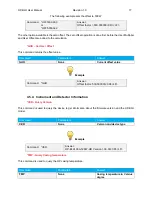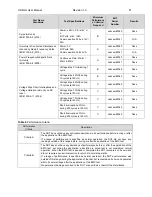
HP-BLU User Manual
Revision 1.0
6
Water temperature:
The cooling water can be between 15 and 25°C but must always remain above the dew point.
The ideal set point is 20.0°C, at which temperature the HP is calibrated.
Water temperature stability is very important since variations (1 to 60 seconds) in the temperature
can be interpreted as laser power fluctuation.
Regulate the temperature with a chiller or a re-circulator.
The water temperature can be monitored with the PC-Gentec-EO software.
Water flow rate:
Flow rate stability is very important since the measured power is directly proportional to water flow.
Variation (1 to 60 seconds) in the flow rate can be interpreted as laser power fluctuation.
The flow rate must be adjusted with a valve. A lower flow rate causes a slower response while
increasing the signal to noise ratio. A higher flow rate causes a faster response, reducing signal to
noise ratio.
The water flow rate can be monitored with the PC-Gentec-EO software.
Note: The water pressure at the HP input must never exceed 60 psi / 413 kPa.
Note: All these parameters should remain in the range stated in the specifications.
1.3.9. Anticipation algorithm
The HP-BLU relies on a calorimetric relation to determine the laser power. This principle provides precise
measurement but it has the drawback of having a slow response. To compensate for the slow response,
HP-BLU provides an anticipation algorithm in the firmware that gives a much faster response. Usually, the
anticipation algorithm reduces the rise time of the power measurement as described in the HP user manual.
The only drawback of using the anticipation algorithm is an elevated noise floor.
The anticipation algorithm can be enabled and disabled in the software or with the serial commands. If your
application needs faster measurement, it is recommended to enable the anticipation algorithm. If your
application needs the most precise measurement possible, then the anticipation algorithm should be
disabled. By default, the anticipation algorithm is on.
1.3.10. Alarms
The HP-BLU can detect 3 kinds of faults. It can detect an over-temperature condition on the device housing
f the water-cooling is insufficient, a low battery charge and it can detect water leaks on the internal PCB.
If one of the fault conditions is detected, the red LED will flash rapidly. The flashing can only stop when the
device is power cycled. If the alarm condition is still there, the flashing will continue.
To clear an over-temperature problem, the water-cooling flow must be increased (within range specification)
or the HP-BLU must be given time to cool down. To remove water on the PCB error, the only thing you can
do is wait until the water has evaporated. Please do not use your Blu HP detector if there is water on the
PCB. The drying time will vary with ambient air humidity and temperature but 24 hours should work. To
clear the low battery charge alarm, please charge the HP BLU with a USB cable.











































